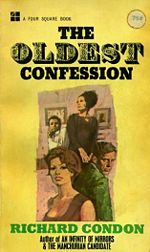The Miernik Dossier: Difference between revisions
imported>Hayford Peirce (began the article -- the cover image will be replaced by another one) |
imported>Hayford Peirce (more) |
||
| Line 3: | Line 3: | ||
{{Image|Oldest Confession paperback.jpg|left|150px|The cover of a 1965 Four Square edition.}} | {{Image|Oldest Confession paperback.jpg|left|150px|The cover of a 1965 Four Square edition.}} | ||
'''The Miernik Dossier''', published by [[the Saturday Review Press]] in 1973, was the first of | '''The Miernik Dossier''', published by [[the Saturday Review Press]] in 1973, was the first of sevens novels by the American novelist [[Charles McCarry]] featuring an American intelligence agent named [[Paul Christopher]]. Set in 1959 in Europe and Africa during the days of the [[Cold War]], it is narrated in the form of reports, overheard conversations, and various documents from a multitude of sources of different nationalities, supposedly giving the reader an authentic picture of what an actual intelligence operation might be like. McCarry had previously been an actual undercover operative for the [[Central Intelligence Agency]] for nine years, and the book was hailed for its apparent authenticity and realistic depiction of [[tradecraft]]. It received excellent reviews, and instantly established McCarry's reputation as one of the foremost American novelist about espionage. | ||
Revision as of 15:58, 3 April 2013
The Miernik Dossier, published by the Saturday Review Press in 1973, was the first of sevens novels by the American novelist Charles McCarry featuring an American intelligence agent named Paul Christopher. Set in 1959 in Europe and Africa during the days of the Cold War, it is narrated in the form of reports, overheard conversations, and various documents from a multitude of sources of different nationalities, supposedly giving the reader an authentic picture of what an actual intelligence operation might be like. McCarry had previously been an actual undercover operative for the Central Intelligence Agency for nine years, and the book was hailed for its apparent authenticity and realistic depiction of tradecraft. It received excellent reviews, and instantly established McCarry's reputation as one of the foremost American novelist about espionage.
